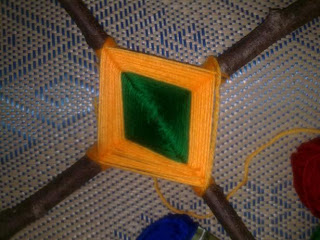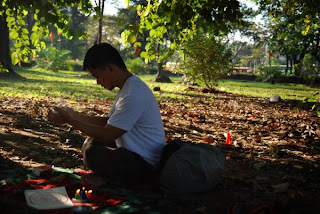Along with seven created beings
I was placed
In a fire of purification.
I was myself gleaming fire,
When I was first given life...
-- The Black Book of Caemarthen, Taliesin
My Imbolc candle, 2009
Imbolc
Imbolc, the first Wiccan Sabbat in the Gregorian calendar, is one of four Sabbats that are adapted from the ancient Celtic fire festivals [1] which are mainly based on agrarian and pastoral cycles. It is usually celebrated on or around February 2, or at the midpoint between winter solstice and spring equinox. 'Imbolc' (pronounced 'imolk') is an Irish Gaelic word meaning 'in the belly'. The festival is also sometimes called 'Oimelc' ('imelk') meaning 'ewe's milk'. Both refer to the time of the year when mother sheep begin to lactate and are ready to give birth again. This period occurs on the early days of February in the British Isles and some traditionalist Pagan groups still determine the time of Imbolc thereon. Around this time, badgers, groundhogs [2] as well as serpents begin to emerge from their burrows, and Galanthus flowers begin to grow through the snow [3] . Other Pagans, especially those who do not experience winter, determine the time of Imbolc astrologically by finding the point in time when the Sun is in 15 degrees the sign of Aquarius. Events in the Wheel of the Year of the southern hemisphere (Australia, New Zealand) are at the exact opposite of their northern counterparts, so Imbolc is celebrated in the lands down under around August 2, the time of the sabbat Lughnasadh in the north.
Imbolc signifies the end of winter and the beginning of warmth and is thus called the "Festival of the Waxing Light". In the Wiccan narrative, it is the time when the goddess has recovered from childbirth, and the Sun god whom she gave birth to in Yule is beginning to grow in strength and power.
Brighid, Celtic triple-goddess [4]
Being a fire festival it is sacred to the Celtic triple-goddess Brighid ('breed'), keeper of the three-fold flames of smithcraft, poetry and healing. In fact, Imbolc is also called La Fheile Brighid, or the day of Brighid. In honor of Brighid as a muse of poetic inspiration, bards and poets usually hold Eisteddfods ('aistedvod') at this time, which is a celebration of song and poetry. Many Pagans also choose this time to cleanse and consecrate their ritual tools and ask blessings from Brighid as the lady of smithing. Brighid is also the patroness of childbirth and the guardian of sacred wells, so Imbolc is also considered as a period of rebirth, transformation and of purification, and an ideal time for initiation and dedication to deity.
 Drying some fragrant Pandan leaves for the leaba brid for this coming Imbolc.
Drying some fragrant Pandan leaves for the leaba brid for this coming Imbolc.
It is a custom to clean the house before Imbolc in preparation for the coming of Brighid, who is also goddess of hearth and home. Bridget's crosses and 'brideogs' ('
brijog)', a corn dolly to represent Brighid, are traditional Imbolc crafts. The brideog is usually placed on a 'leaba brid' ('
lawa bree'), or the bed of Brighid, and placed in the bed with the brideog is a phallic wand called the 'slatag brid' ('
slatag bree'). Butter, milk and a lit candle is placed on the window sill on the eve of Imbolc to welcome Brighid as she walks the earth during the night. A piece of cloth is placed upon a shrub for Brighid to bless as she passes by. The cloth, called 'brat brid' ('
brat bree') is imbued with powers of protection and healing thereafter, and is sometimes cut to smaller pieces and sewn to garments, blankets or pillows.
'Presentation of Jesus at the Temple', Giovanni Bellini
Candlemas
Candlemas is a related yet different festival although some Wiccans today use the term interchangeably with Imbolc. It is a Christian feast to honor the presentation of Jesus at the temple. This occasion actually consists of three important events for the Christian belief:
- An ancient Judaic ritual for the child Jesus called "Pidyon Ha-ben", whereby the first born male is redeemed from the Priest by the father of the child, in exchange for a small amount of coins. This is still being practiced today by the Jewish religion.
- A ceremonial purification of Mary, mother of Jesus. In ancient Judea, a woman is considered impure after giving birth and must undergo a ritual of purification 40 days after giving birth to a male child, and 60 days to a female child.
- The declaration of Jesus as the light and redeemer of the world by the prophet Simeon.
The rituals of redemption and purification are in accordance to the laws given by Moses in the book of Leviticus. Like Imbolc, Candlemas is also a festival of fire, celebrating Jesus as the light of the world, and of purification. Traditionally it is a time when the priest blesses candles to be used in the church or at home throughout the entire year. Ancient Christian leaders declared the celebration of this feast at February 2, the time of Imbolc, in keeping up with the Pagans of the lands they were ruling.
Philippine Wiccan Society, Imbolc 2009
Candelaria, as it is called in Mexico and other Spanish-speaking countries, is also celebrated in the Philippines, most notably in the towns of Jaro, Ilo-ilo and Silang, Cavite. Pope John Paul II declared Nuestra Señora de Candelaria as the patroness of Western Visayas during his visit to the country in 1981 [5]. Her feast day is celebrated with mardi-gras-like candle-lit parades and is one of the biggest annual festivals in the Visayas region. For followers of Santeria, a syncretic religion mainly practiced in Latin America, this is a sacred day to the Yoruban goddess Oya, who is syncretized with Our Lady of Candelaria.[6]
The ancient Roman festival of Februatio is also a ritual of purification that happens around this time. 'Februa' is an instrument or offering for atonement or purification, and it is in fact where the month of February gets its name from. It is also more commonly known as Lupercalia, and is also a fertility festival from which the modern Valentine's Day is said to be derived. Followers of Stregheria, or Italian witchcraft, still celebrate the feast of Lupercalia.
There are many other celebrations around the world that parallel the Wiccan festival of Imbolc, like the Aztec and the Chinese New Year, but the ones mentioned here are what I consider to be its closest relatives.
Basbasan Nawa!
[1] The other three being Samhain, Beltaine, and Lughnasadh.
[2] Hence its association with Groundhog Day, celebrated in North America on February 2.
[3] Also called Snowdrop, a pretty little white flower
[4] "Brighid", by Miranda Gray
[5] Pope John Paul II himself also crowned the image of Our Lady of Candelaria in the Cathedral of Jaro.
[6] Thanks to my Lucumi friends I'm finally getting the grasp of New World religions and their relation to Old World Paganism.
More Reading:
[a]
Imbolc and the Goddess, by Tira Brandon-Evans
[b]
ADF Imbolc Traditions 
























































